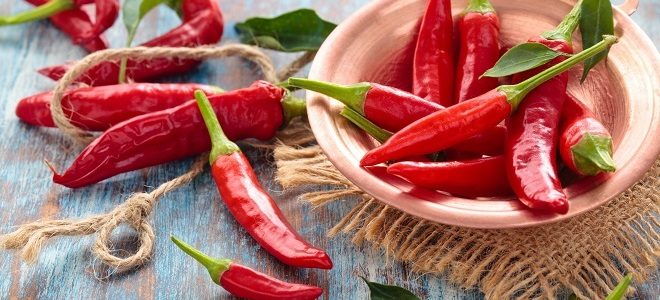 Many of us love the hot thing. And although we do not live in South America or India, where all the dishes are very spicy, nevertheless on our, Russian tables of hot pepper seasoning, it is not such a rare occurrence.
Many of us love the hot thing. And although we do not live in South America or India, where all the dishes are very spicy, nevertheless on our, Russian tables of hot pepper seasoning, it is not such a rare occurrence.
Gardeners are increasingly testing various varieties of burning culture in their gardens and are happy to use the resulting fruits as a spicy addition to dishes.
Content
The best harvested varieties of hot pepper
Varieties of hot peppers, of course, are not as many as sweet ones. But still, even among the existing abundance, it is easy to get lost when choosing the right pepper. All types of peppers are different in terms of ripening, methods of cultivation and the degree of burning of the ripened product. They also differ in the types of bushes, decorativeness and purpose. One of the important priorities in choosing a pepper variety is its yield. In this article we tried to collect the most fruitful varieties that can be grown in any climatic zone of our country.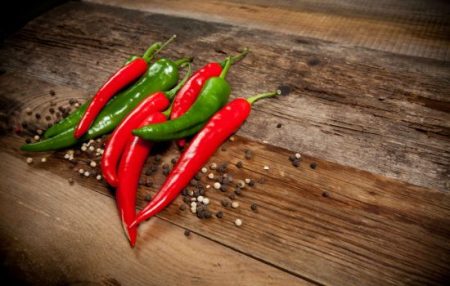
Elephant trunk 304
This variety is the brainchild. breeders of the Maykop experimental station of the All-Union Research Institute. This type of bitter pepper was bred by multi-seed selection from the local Abkhazian sample K-304 of the VIR collection. Year of appearance - 1952. Recommended cultivation in sheltered soil, so a high-quality crop can get a lot more. However, as practice shows, growing in open areas, the Elephant trunk 304 also shows excellent results.
Elephant trunk - mid-early variety. The vegetation period of plants lasts an average of 120-140 days. Before biological maturity, at which seed collection can take place, 155 days pass. Peppers of this variety are very high quality and productive. The variety is mid-ripening (mid-early) in terms of fruit ripening. During ripening, peppers have a light green color, which at the time of full ripeness turns into rich red.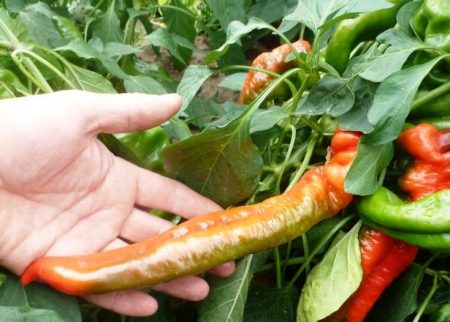
The bushes grow sprawling, low, up to 60 centimeters high. The stem is green, with a slight violet-brown pigmentation. There are not very many leaves on the bush, so the fruits are under the sun, and therefore enriched with taste and color. The leaves themselves are smooth, dark green, medium in size, elongated and rounded. Inflorescences are single white. The fruits grow wilted. They are very elongated, curved, similar in shape to cones. The number of chambers is 2 or 3. The tip of the pepper is slightly rounded, which is similar to the trunk of an elephant. In length, the fruits are stretched to 15-18 centimeters, weighing 25-40 grams. The pulp is friable, juicy, with moderate severity of taste.
Productivity is quite high and amounts to 20 kilograms per square meter.
Sowing seeds of pepper of this variety for seedlings should be carried out in February. Harvesting occurs in the first month of summer. The fruiting period is 50-90 days.
The distinct advantages of the variety also include excellent keeping quality of peppers, as well as the ability not to deteriorate during long-term transportation. All useful, marketable and taste qualities will be preserved by more than 95%.
Filius Bleu
Among several hundred varieties of hot pepper there are decorative species that can "burn out" any dish with only one kind. Hot pepper Filius Bleu (original name Filius Blue) is just such a variety of pepper. It has some features that are unique to this decorative variety.
Firstly, its thin, slightly curved cone-shaped fruits are painted in an unusually bright purple color, which, upon final maturation, turns into a burgundy. This color gives the peppers a unique charm. Secondly, its compact semi-spreading, ram-shaped bushes grow up to no more than 20 centimeters. This property of the variety suggests that burning plants can be grown even in a pot on the windowsill, and not just on the garden bed. Thirdly, undersized plants bear fruit abundantly, and the peppers, similar to violets, can stay on the stems without spoiling for a very long time. The sharpness of the pepper is about 30,000 SHU.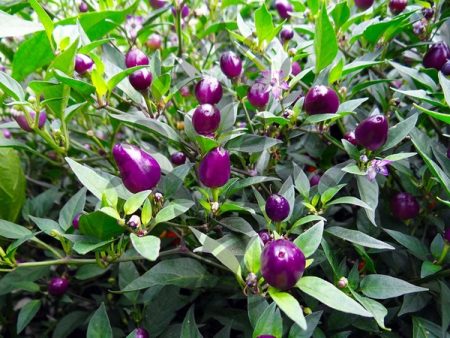
In order for the plants to please longer with numerous beautiful and very sharp fruits, it is necessary to observe the correct agricultural technique: water the bushes in a timely manner, keep them in the light, evenly turning in different directions to the sun during the day. Filius bleu does not like dryness and heat, and therefore it is better to produce frequent spraying of leaves even on cloudy days.
Crops of pepper for seedlings are produced in March. For the seedling period, only light and loose soil with a large number of fertilizers is selected. The optimum temperature for seed germination is 22 degrees Celsius. The first shoots appear two weeks after sowing. As well as sweet varieties of pepper, this variety is required to dive in the development stage of 2-3 leaves. A pick is best done in a large container, as the bush will grow and bear fruit directly in it. 80 days after the pick, the first peppers ripen. Bushes bear fruit abundantly and continuously, up to 5-6 months.
Most often, Filius blue is grown exclusively for decorative purposes, as the bushes bloom with pleasant lilac flowers. Not all fit the sharpness of edible chili peppers. However, if you observe the concentration, then the dishes in which to add peppers of this variety acquire a peculiar piquancy.
Ryabushka
Another decorative variety, which is famous for compact, branched, almost spherical bushes, growing 25-30 centimeters. The first fruits appear on the hundredth day after the appearance of the first seedlings. The peppers themselves are formed round, single. The size of the peppers is 2 * 2 centimeters. The average weight of peppercorns is very small and is 5-10 grams. The color of the fruit in the stage of technical ripeness - purple and dark orange - in the biological stage of ripening. They quite colorfully stick up, creating the likeness of a flower bouquet. The fruits ripen very long (the growing season is 140 days), and the fruiting period lasts several months.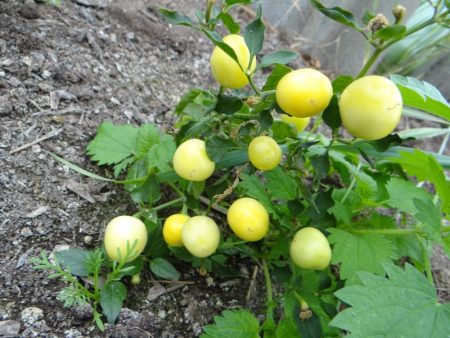
Fruits variety Ryabinushka gives very sharp, with a pleasant pepper aroma. Basically, peppercorns are used to make paprika and other spices, as well as various pastas. You can also use Ryabinushka as a vegetable supplement to main dishes.
Additional advantages of this variety include its versatility in growing: seedlings can be planted in open ground, in a greenhouse or left at home on a windowsill in a pot. In cultivation Ryabinushka unpretentious. Plants easily tolerate the lack of sunlight, temperature changes and grow well in a small amount of land. Their root system is very convenient to grow, for example, in a flower pot. Even in winter, with additional lighting, peppers bloom and bear fruit well. In different seasons of the year, their unique taste remains unchanged.
Cayenne
Cayenne pepper is a varietal variety of peppers from which various spices are made. Fresh, these peppers are usually not consumed.
Cayenne peppers are grown not only in places of its mass consumption - Africa, India, South America and Western Europe. They are grown everywhere, since cayenne pepper is one of the best hot spices in the world. Cayenne peppers include varieties of "chili", and "Brazilian pepper", and "Indian pepper".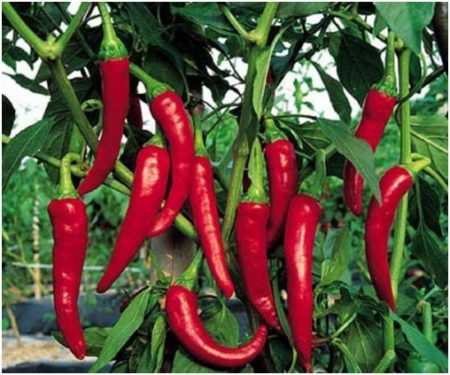
Plants of this culture are quite tall and often reach a height of one and a half meters. The foliage is large, elongated, light green. The plant blooms in large white inflorescences. The fruits of cayenne pepper may be different in shape. Usually they are either conical or rounded. The peppers are small in size and reach a length of 10 centimeters. They also differ in color: at the stage of biological maturity they can be painted in white, pink, orange and red tones. In the stage of immaturity, the fruits are either purple or green.
The inside of the peppers is packed with numerous cream-colored seeds. Fruits the plant for several months. And if you grow bushes at home, you can manage to harvest all year round
This variety of chili peppers is very popular all over the world because of its rich chemical composition. Due to the presence of minerals, vitamins and phytonutrients in it, the use of this pepper, even as a seasoning, can affect the body and endow it with useful trace elements.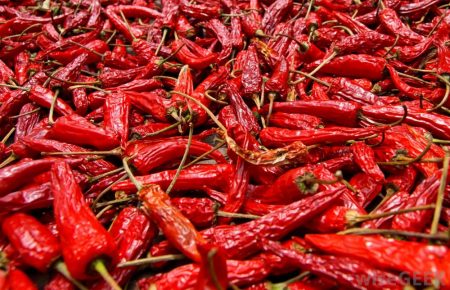
Hundreds of years ago, cayenne pepper was used not as an addition to dishes, but specifically for medicinal purposes. Many studies show that this pepper enhances immunity, positively affects the functioning of the heart and blood vessels, reduces blood glucose, prevents the formation of ulcers, stimulates appetite, reduces inflammation, soothes pain, and acts as a powerful dioxide. This is not the whole list of miraculous properties of this pepper.
Cayenne pepper is the most widely used pepper in the world. Based on this pepper, a huge amount of drugs and dietary supplements has been created. Its use is designed to improve digestion, normalize metabolism, etc.
Twinkle
One of the most common varieties of peppers, suitable for growing indoors. The variety belongs to the genus Capsicum. He appeared due to the crossing of the Cayenne and Chilean species.
Spark is a medium-ripening variety. If you plant seedlings in May, then in July you can already enjoy the pleasant burning aroma of dishes. The fruits reach technical ripeness 120 days after sowing. And biological - even after 20 days.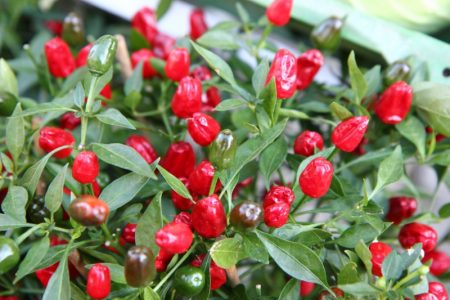
Fact: The advantage of the variety is that it can also be grown in open ground and in a greenhouse.
Medium-growth highly leafy shrubs that grow to a height of 60 centimeters form fairly large fruits for chili peppers weighing up to 45 grams. The shape of hot pepper, like the bulk of these varieties, is pod-shaped, strongly elongated, and bright red. On the bushes there are a lot of small fruits that completely strew the plant.
The variety has the ability to bring abundant crops: at home, the bushes form up to 4 kilograms of selected hot peppers. In open ground, the yield is somewhat lower.However, if you pay as much attention to seedlings as possible, water abundantly and feed the bushes at least three times a season, you can increase the yield of red hot pepper by a couple of kilograms.
Another advantage that the gardener will not ignore is the persistent confrontation of the pepper Spark to bacteriosis and verticillous wilting. With proper care, the bushes rarely get sick. They grow powerful, spreading.
The Ogonyok variety peppers are often used for medicinal purposes, using it as decoctions, seasonings and tinctures. It is highly regarded for its ability to stabilize blood sugar, and reduce the risk of developing various tumors and ulcers.
In cooking, seasonings from this pepper are especially popular. Not a single dish in many restaurants is cooked without the use of this pepper.
Spanola
Excellent hot early ripe pepper, which has moderate stinginess. This pepper hybrid takes root perfectly in any climatic zone. And also it can be planted both in open beds and in greenhouses. In any case, the yield will be very impressive - from one square meter you can collect up to 4.5 kilograms of beautiful peppers, which will give any dish a special highlight.
Crops of seeds of this pepper for seedlings are usually carried out in February, so that by August it was possible to collect a full crop of ripened peppers. You can also plant new seedlings of pepper in July, then by October a new wave of healthy fruits will ripen.
The ripening of the first peppers is approximately 110 days after the appearance of the first shoots. Medium-sized plants, sometimes reaching 120 centimeters in height, have medium leafy and compact forms. The fruits are cone-shaped, very long and narrow. In length, usually stretch up to 30 centimeters. The mass of peppers is considerable - 40-45 grams. The peel is dense, shiny, bright red.
It is better to form bushes in 3 or even 4 stems. Thanks to the extra shoots, there are so many fruits on the bush that by their size they completely cover the crown of the bush.
Peppers with the Spanish name Spagnola are very demanding on watering, top dressing, lighting and heat. If the summer is cooler, it is better to keep the bushes under the film, occasionally lifting it for ventilation.
Spaniola peppers are not very hot, so they can be consumed even fresh and added to salads and main dishes. They get a great taste in canned form along with other vegetables.
Spear of an Indian
Pepper with the original name Indian Spear is intended for cultivation in any climatic zone, and it can also be cultivated both in open ground and in greenhouse conditions.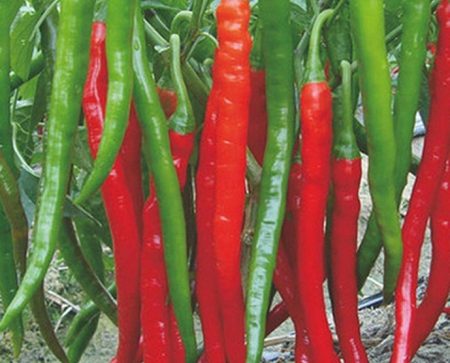
This variety is early ripe, and therefore ripened peppers can be used as early as 105 days after sowing. Plants are indeterminate type, grow more than 125 centimeters in height. The bushes are branched, sprawling, with a dark green dense crown. Garter to the support and formation are required.
In biological ripeness, peppers have a bright red color, weighing up to 10 grams. They have the shape of an elongated cone, standard for hot peppers. The fruits have a strong degree of burning, and therefore are mainly used for canning or cooking marinades. You can also dry the fruits of pepper and use as a seasoning for main dishes.
Sowing seedlings is carried out in February, seedlings are planted in early May, placing up to 5 bushes on one square meter. With constant watering, loosening and weeding, the yield per square meter reaches two kilograms.In the greenhouse, this figure is slightly higher and reaches three kilograms. The main value of this variety in its high productivity and presentation of the resulting fruit.
Tone 9908024
Mid-early grade of bitter pepper, which is very fond of summer residents. They choose it because it is very productive - from one square meter you can get up to four kilograms of burning vegetable.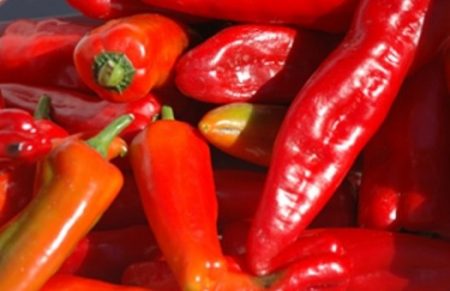
Tone - mid-early ripening. So that the fruits can be eaten, you have to wait at least 120 days. And peppers reach biological maturity only 145 days after sowing.
Tonus fruits are predominantly small, cone-shaped, but not as long as most hot peppers, often weigh no more than 15 grams. Peel peel is smooth, shiny. When fully ripened, the surface is painted a typical red color.
Bushes of this variety are medium-sized, not very branched. The leaves are medium in size, notable for their slight wrinkling. The advantage of this variety is that its plants do not need to be formed, but can only be tied up a couple of times.
The main advantages of Tonus include its high resistance to many diseases, including viral infections.
Tip: This pepper variety boasts excellent pot life. Plants grow well in open ground even in Siberian conditions.
Astrakhan 147
One of the oldest domestic varieties of hot pepper, which has established itself over time. The variety was created back in 1943 breeders of the Volgograd experimental station of the All-Russian Research Institute of Plant Industry. Initially, it was intended for cultivation only in the southern regions of the country in open ground. However, today Astrakhan 147 is also widespread in the middle latitude.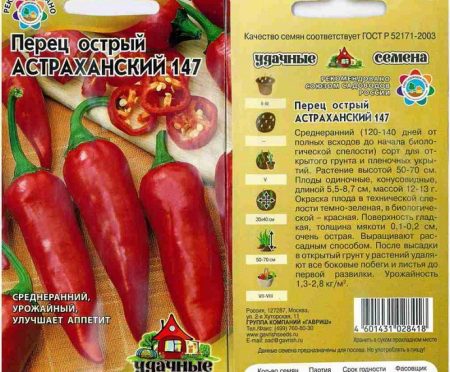
The variety became famous, first of all, because of the high productivity of selected peppers. From one bush on average it turns out to collect up to 30 very small peppers, whose weight reaches 24 grams.
The fruits themselves grow on the bush drooping, very massively located on the branches of plants. The peel is dense, thick, glossy, bright red. The taste of Astrakhan peppers is very burning and spicy.
Bushes are half-stem medium-sized plants, the height of which is 50-60 centimeters. The stems and nodes are green, with a slight purple pigmentation. Foliage of the usual form. Inflorescences are single, white.
Astrakhan 147 - medium early variety of hot pepper. The growing season is 120 days. Peppers reach biological maturity by 150 days. Due to its ability to stretch fruitfully, fruits can be removed for several months in a row.
This variety is highly valued because of its plasticity: it easily gets used to any environmental conditions, rarely gets sick.
Due to the content in its tissues of a huge amount of useful trace elements, Astrakhansky pepper is widely used for medicinal purposes in various fields of medicine.
Astrakhan 628
Another productive variety intended for growing in a greenhouse. This variety is very fond of warmth, and even during periods of drought and intense heat calmly tolerates disasters and does not dump flowers.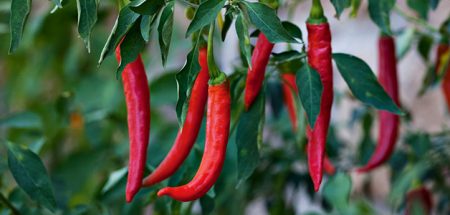
The bushes are characterized by stunting, the height of the bush does not exceed 50 centimeters. Despite its compact size, each plant forms up to 15 fruits of medium and small sizes.
The peppers themselves grow solitary, look like a cone, extend up to 10 centimeters and weigh an average of 20 grams. The pulp is thin and loose. The color of the peppers in full ripening is scarlet. The taste is pronounced, the aroma is strong, spicy.
Reviews
Veronica
Once my friends recommended the Ryabinushka variety to me.Seeing the shrub on the packaging, which is already very exotic in appearance, I immediately decided to buy one pack from Aelita. It seemed to me that the peppers on the bush look very beautiful, which means they will look even better in a jar of pickles!
The seeds are very small, sowing, I thought that half would be lost. However, the seedlings rose amicably and quickly enough. And pepper quickly bloomed with small lilac and white flowers. It turned out that from one bag, two types of pepper were obtained: some peppercorns grew cone-shaped and very small. In the stage of technical ripeness, the peppers, which grew no more than two centimeters in length, were pale yellow. And when ripe, they were painted red. Also obtained were round peppers, balls, which when ripe were purple, and then turned orange. In their appearance, they really resembled in some way mountain ash fruits. I grew peppers in the open ground.
Lyudmila
I always buy different varieties of hot pepper, bushes 5-6, no more. In principle, I grow them for more pampering. So, according to my observations, I realized that hot peppers should grow only in the sun, because in the shade they are not the same sharp and spicy. If you constantly keep them in a lack of lighting, then it ripens longer, and there is almost no stickiness. Therefore, for the sake of seasoning, I plant two or three bushes directly in the sun, and the rest in the shade, so that they can be added to salads and then run with a “burning mouth”.
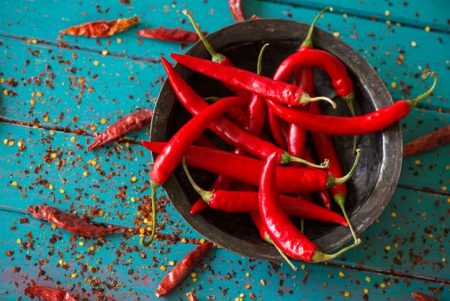
Martha
We live in Siberia. We have hot pepper in high esteem - the blood makes us move faster when it is very cold. I recommend everyone a grade of hot pepper "Adjika". Very good, and most importantly fruitful variety. I plant them only 5-6 bushes, and the harvest so much that next summer you will not eat. Bushes grow to the envy of everyone. The stems are strong, the leaves are large, and the fruits are what! A sight for sore eyes! Very tasty, fragrant, decorate any dish!
Marina
Planted peppers Indian Spear - a very good variety, and most importantly fruitful. Planted seeds for seedlings in March immediately in peat cups. The bushes grew very amicably, such strong, powerful. I was even afraid that they would become cramped, and did not have time to transplant them into the ground. However, everything went smoothly. The seedlings carried the transportation superbly.
Peppers bloomed very abundantly, and in July it was already harvesting. There are a lot of pods on the bush. All are of the same shape and about 7-10 grams in weight. I was pleased that these peppers are easy to care for, you just need to water and yes weed. She didn’t even add fertilizers, so the peppers tied the fruit well. In general, a good grade. The next year I have already collected my seeds, let's see what grows.




 Calorie pepper stuffed with meat and rice - BZHU per 100 grams
Calorie pepper stuffed with meat and rice - BZHU per 100 grams Gorky pepper - the best varieties for open ground
Gorky pepper - the best varieties for open ground Hot pepper seeds - the best varieties for open ground and reviews
Hot pepper seeds - the best varieties for open ground and reviews Capsicum tincture for hair - how to use and reviews
Capsicum tincture for hair - how to use and reviews